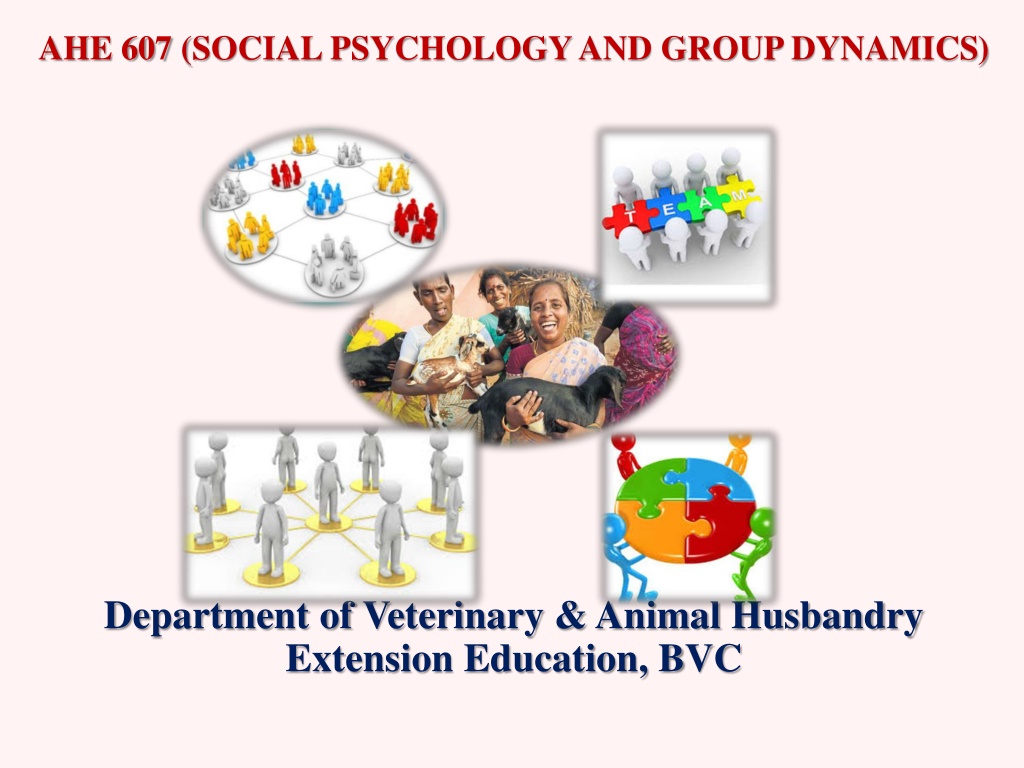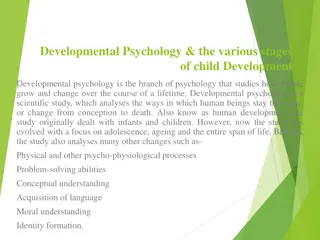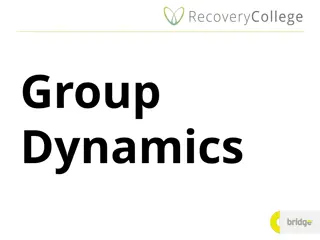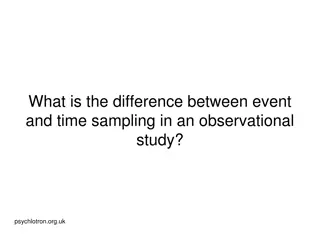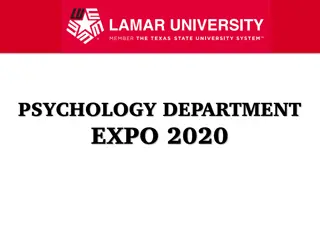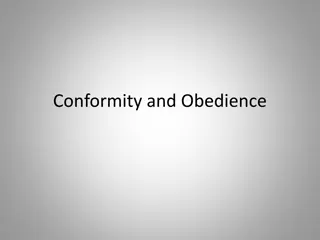Understanding Group Dynamics in Social Psychology
Explore the dynamics of group development in social psychology, covering topics such as types of groups, group structures, conflict resolution, and stages of group development according to the Five-Stage Model proposed by Bruce Tuckman. Learn about the Forming, Storming, Norming, Performing, and Adjourning stages, each essential for effective team building and problem-solving within groups.
Download Presentation

Please find below an Image/Link to download the presentation.
The content on the website is provided AS IS for your information and personal use only. It may not be sold, licensed, or shared on other websites without obtaining consent from the author. Download presentation by click this link. If you encounter any issues during the download, it is possible that the publisher has removed the file from their server.
E N D
Presentation Transcript
AHE 607 (SOCIAL PSYCHOLOGY AND GROUP DYNAMICS) Department of Veterinary & Animal Husbandry Extension Education, BVC
Topics covered Topics covered Concept and types of groups; Typology and importance in rural development Group structures - attraction, coalition, communication and power. Processes in group development and group identity. Factors affecting group performance; Conflicts in groups; Group belongingness.
Stages of Group Development
The model of group development was first proposed by Bruce Tuckman in 1965. He maintained that these phases are all necessary and inevitable in order for: the team to grow to face up to challenges to tackle problems to find solutions to plan work and to deliver results.
The Five-Stage Model of Group Development Consists of the following stages: 1. Forming Stage 2. Storming Stage 3. Norming Stage 4. Performing Stage 5. Adjourning Stage
FORMING STAGE The first stage in group development, characterized by much uncertainty. In this, the team is formed and members meet. They learn what the team opportunities and challenge will be. Members will agree on goals and assign actions for work and ground rules or team guidelines are established. At the start, the team leader may be a member of the group, a supervisor, a manager, or a consultant who will facilitate the team-building process. Leadership will help the team to define their processes. At this stage, the leader needs to be directive and understand the requirements for team training. This stage is complete when the members have begun to think of themselves as a part of a group.
STORMING STAGE The second stage in group development, characterized by intragroup conflict. During the second stage, individual expression of ideas occurs and there is open conflict between members. Members tend to focus on details rather than the issues and compete for influence. Low trust among team members is an evident indicator of this stage. The team needs to select their desired leadership style and decision methodology. The team leader can help by stressing tolerance and patience between members. The leader should guide the team process towards clear goals, defined roles, acceptable team behavior, and a mutual feedback process for team communication. When this stage is complete, there will be a relatively clear hierarchy of leadership within the group.
NORMING STAGE The third stage in group development, characterized by close relationships and cohesiveness. In the third stage, the team develops work habits that support group rules and values. They use established tools and methods; exhibit good behaviors; mutual trust, motivation, and open communication increase; positive teamwork and group focus are apparent. The team relationships grow and individual characteristics are understood and appropriately utilized. The team leader continues to encourage participation and professionalism among the team members. This stage is complete when the group structure solidifies and the group has assimilated a common set of expectations of what defines correct member behavior.
PERFORMING STAGE The fourth stage in group development, when the group is fully functional. The fourth stage shows high levels of loyalty, participation, motivation, and group decision-making. Knowledge sharing, cross-training, and interdependence increases. Team is self-directing in development of plans and strategy to meet their goals and carry out work. Personal growth and sharing is encouraged throughout membership. The leader becomes a facilitator aiding the team in communication processes and helping if they revert to a prior stage. Group energy has moved from getting to know and understand each other to performing the task at hand. Note: For permanent work groups, performing is the last stage in group development.
ADJOURNING STAGE The final stage in group development for temporary groups, characterized by concern with wrapping up activities rather than performance. For project teams, temporary committees, or task forces coming to an end, there will be a finalizing stage as they celebrate and recognize group achievement. Then some mourning over the dissolving of the team relationship and begin planning for the change in individual work requirements. During this stage, leadership needs to emphasize organization gratitude and both team and individual recognition. For continuous work teams, there may be a higher performance level as they develop and transform as individuals and reform into revised teams. It is important to note that continuous work teams may revert to prior stages when new people are added to the team.
Types of Groups
FORMAL GROUP INFORMAL GROUP A group that is neither formally structured now organizationally determined; appears in response to the need for social contact. A designated work group defined by the organization s structure.
FORMAL GROUPS In formal groups, the behavior that team members should engage in are stipulated by and directed toward organizational goals. The major purpose of formal groups is to perform specific tasks and achieve specific objectives defined by the organization. The most common type of formal work group consists of individuals cooperating under the direction of a leader. Examples of formal groups are departments, divisions, taskforce, project groups, quality circles, committees, and boards of directors.
FORMAL GROUPS Characteristics of Formal Groups: They are approved from some authority. There is fixed division of labour Individuals are assigned specific responsibilities. There are personal interactions between the group members. Group members are rewarded. Formal groups can be further classified into: Command Groups Task Groups
Command Groups A group composed of the individuals who report directly to a given manager. It is determined by the organization chart. Membership in the group arises from each employee s position on the organizational chart. Examples of a command group are: an academic department chairman and the faculty members in that department, or a director of postal audits and his five inspectors.
Task Groups Task groups consist of people who work together to achieve a common task. Members are brought together to accomplish a narrow range of goals within a specified time period. A task group s boundaries are not limited to its immediate hierarchical superior, it can cross command relationships. Task groups are also commonly referred to as task forces. The organization appoints members and assigns the goals and tasks to be accomplished. All command groups are also task groups, but reverse need not be true. Examples of assigned tasks are the development of a new product, the improvement of a production process, or the proposal of a motivational contest. Other common task groups are ad hoc committees, project groups, and standing committees.
INFORMAL GROUPS These groups are natural formations in the work environment that appear in response to the need of social contact.
